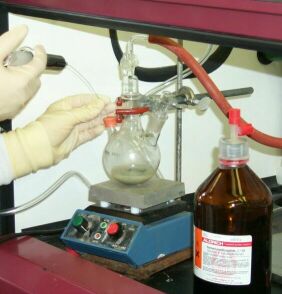Top Qs
Timeline
Chat
Perspective
Barbier reaction
Reaction in organic chemistry From Wikipedia, the free encyclopedia
Remove ads
The Barbier reaction is an organometallic reaction between an alkyl halide (chloride, bromide, iodide), a carbonyl group and a metal. The reaction can be performed using magnesium, aluminium, zinc, indium, tin, samarium, barium or their salts. The reaction product is a primary, secondary or tertiary alcohol. The reaction is similar to the Grignard reaction but the crucial difference is that the organometallic species in the Barbier reaction is generated in situ, whereas a Grignard reagent is prepared separately before addition of the carbonyl compound.[1] Unlike many Grignard reagents, the organometallic species generated in a Barbier reaction are unstable and thus cannot be stored or sold commercially. Barbier reactions are nucleophilic addition reactions that involve relatively inexpensive, water insensitive metals (e.g zinc powder) or metal compounds. For this reason, it is possible in many cases to run the reaction in water, making the procedure part of green chemistry.[2] In contrast, Grignard reagents and organolithium reagents are highly moisture sensitive and must be used under an inert atmosphere without the presence of water. The Barbier reaction is named after Philippe Barbier, who was Victor Grignard's teacher.

Remove ads
Scope
Examples of Barbier reactions are the reaction of propargylic bromide with butanal with zinc metal (The attached reference details that the reaction goes to completion after the addition of saturated aqueous ammonium chloride):[3]

the intramolecular Barbier reaction with samarium(II) iodide:[4]

the reaction of an allyl bromide with formaldehyde in THF with indium powder:[5]

The Barbier reaction is accompanied by an allylic rearrangement to a terminal alkene
The reaction of 3-Bromocyclohexene with benzaldehyde and zinc powder in water:[6]

Remove ads
Asymmetric variants
The synthesis of (+)-aspicillin, starts first with a hydroboration, then transmetallation to zinc which can then do an addition into the aldehyde substituent.[7]

See also
External links
- Barbier reaction @ University of Connecticut Website
References
Wikiwand - on
Seamless Wikipedia browsing. On steroids.
Remove ads
